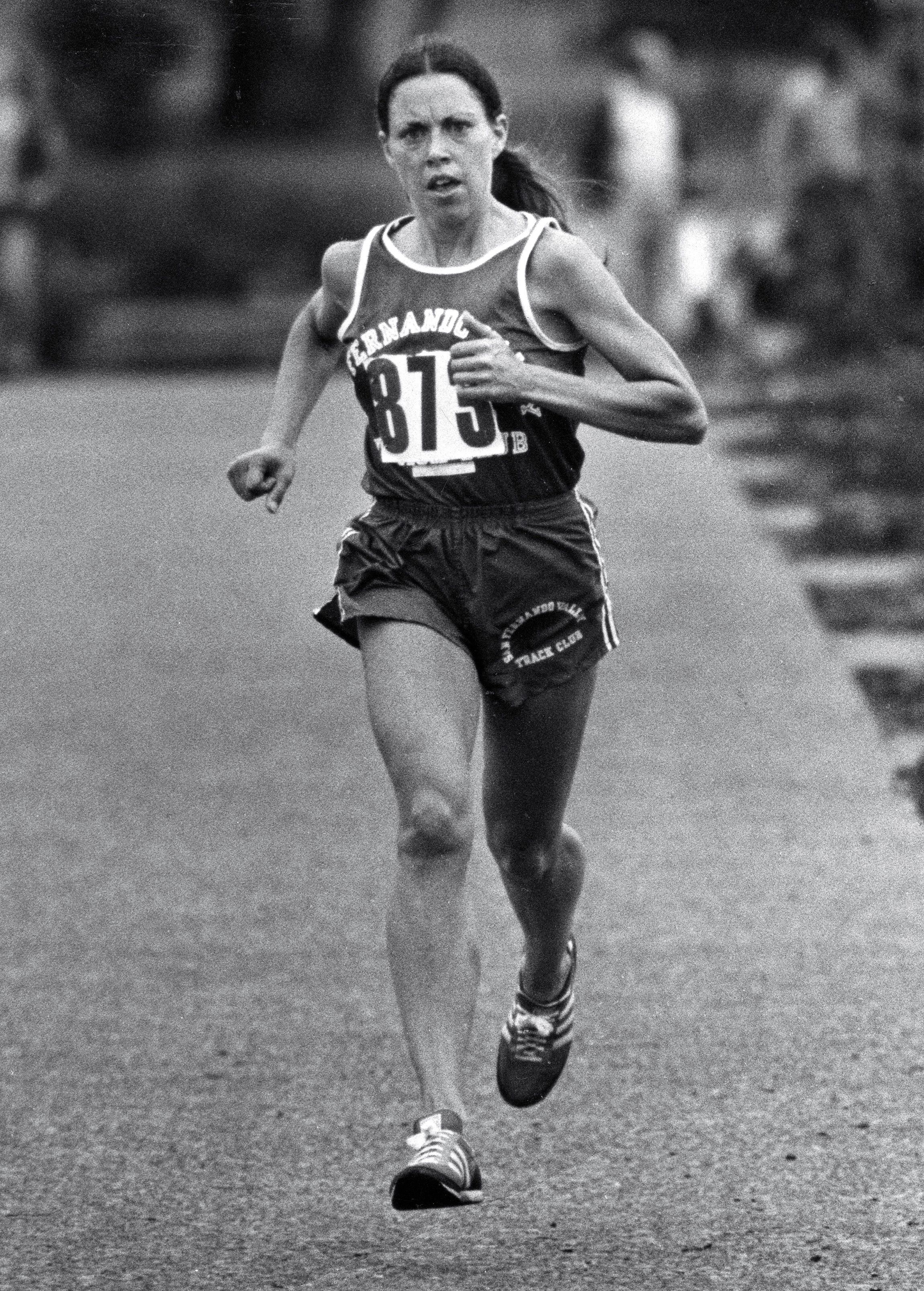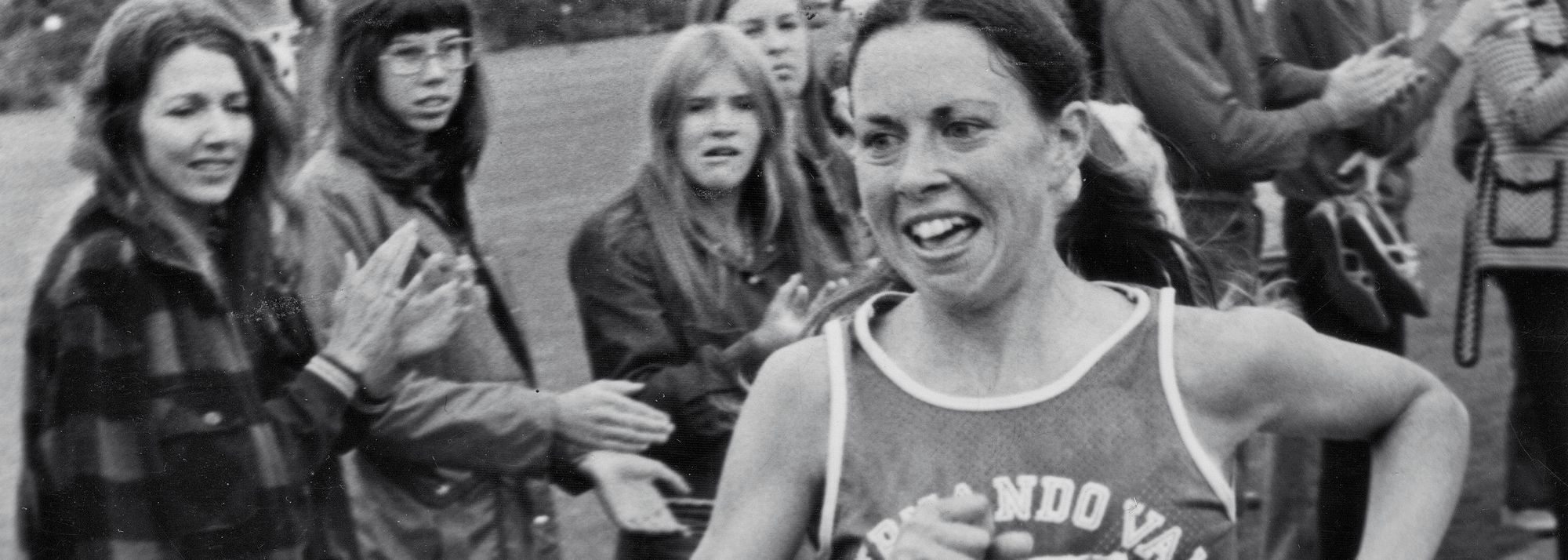Jacqueline Hansen at the 1975 Nike-Oregon Track Club Marathon in Eugene
At the start of October in 1975, distance running for women was still a fringe activity. For women Olympians, laying the foundations for the following year’s Games in Montreal, there was nothing farther than a mile to test their endurance. The 1500m was the limit of their horizon. But not of their ambition, thankfully.
In the second week of that month, Jacqueline Hansen travelled from her home in the San Fernando Valley, north of Los Angeles, to Eugene, Oregon, to run in the Nike-Oregon Track Club Marathon. Her performance on 12 October 1975 was to be a momentous one for the women’s marathon. World Athletics Heritage is delighted that Hansen has very kindly donated the shoes she wore on that day in Eugene to the World Athletics Heritage Collection and the 3D virtual Museum of World Athletics (MOWA).
Distance running pioneer
A sprinter and hurdler in her youth at Granada Hills High School, where the celebrated American Football quarterback John Elway was also educated, Hansen had been busy pushing the boundaries as one of the event’s pioneers for three years.
She made a winning debut in the grandly titled Western Hemisphere Marathon in Culver City in 1972, clocking 3:15:53, then was the first woman home in the following year’s Boston Marathon, improving to 3:05.59.
In 1974 she broke three hours for the first time, running 2:56:25 for fifth place in the International Women’s Marathon Championships at Waldniel in West Germany, then broke the women’s marathon world record for the first time.
Hansen’s time in the 1974 Western Hemisphere Marathon in Culver City, 2:43:54.5, was the first sub-2:45 run by a woman and a significant advance on the 2:46:24 set by Chantal Laglace of France in Neuf Brisach two months previously.
‘As close to six minutes [per mile] as I can’
A more significant barrier was to be breached in Eugene in October 1975.
By then, the record had been lowered to 2:40:15.8 by Christa Vahlensieck of West Germany and, while Hansen set off to Oregon “with no particular expectation but to run as best I could”, her focus suddenly sharpened when she was out training with some locals a few days before the race.
As she recalled in an article for Running Times in May 1980: “When asked about my intended pace in the race, with scarcely any hesitation I replied, ‘As close to six minutes [per mile] as I can.’
“Because that’s what it would take to break the existing record, I guess it was what first came to mind. But when I took time to assess the statement, I wondered at myself.
“Sure, I’d last run 2:43; and to date I’d always improved by leaps and bounds. But to break 2:40…”
It was no small step: more of a giant leap for the womankind of marathon running, breaking through into 2:30-something territory and paving the way for Grete Waitz and the push way below the two-and-a-half-hour Rubicon.
“I knew that a world record was within reach – if I didn’t die”
“We started the race, a mere 100 or so of us, and for all I know I could have been the only woman entrant,” Hansen recalled. “The weather was ideal, with cloud-covered skies and cool temperatures.
“The course was flat and wound through the forests of the Willamette River at some points. Everything seemed conducive to a good performance.
“I passed the first mile in 6:08 and averaged 6:02 per mile for the distance. Hearing a split of 2:01 at 20 miles, I knew that a world record was within reach – if I didn’t die.
“Instead, adrenalin flowing, I ran the final six miles at sub-six-minute pace and finished covered with goose-bumps. That performance has remained the greatest of my running career.”
Hansen crossed the line in 2:38:19. Her time would have been an absolute world record until 1909, when Great Britain’s Harry Barrett became the first man to break 2:40, during a 50-mile track race at London’s Stamford Bridge.

Advocate for the cause of women’s distance running
“I had more than a year and a half to savour my world record,” Hansen recalled. “During that time, I took the opportunity to lobby in various ways for the ‘cause’ of a women’s marathon in the Olympics. I spoke to anyone who would listen.
“The exclusion of women distance runners in the Olympic Games had been a never-ending source of frustration to me since 1972. I wanted other women runners to realise that my achievement was not so spectacular; that we all should be running in the 2:30s; that women would – should – be running in the 2:20s in five years.
“Only four years later, enter Grete Waitz. I was attending a sports good show in Los Angeles when word came to me of her tremendous 2:27 in the New York City Marathon. My skin prickled with goose bumps, as it had in Eugene four years before.”
And with good reason. Four years later, in 1983, the inaugural World Championships in Helsinki featured a women’s marathon – fittingly won by the great Grete. The year after that, Waitz finished runner up to Joan Benoit in the inaugural Olympic women’s marathon in Los Angeles.
The 2:25, 2:20 and 2:15 barriers have been swept aside. The women’s world record for the marathon now stands at a stunning 2:14:04 to Kenya’s Brigid Kosgei.
Hansen played a campaigning role as well as an inspirational one. She was president of the International Runners Committee, which successfully lobbied the International Olympic Committee to add women’s events for the 5000m, 10,000m and the marathon.
Tabori trained
It all might never have happened had Hansen not bumped into Judy Graham while on a daily one-mile jog around the campus at Northridge College in the autumn of 1970. The pair began running together regularly and Graham, a competitive miler, introduced Hansen to the coach of the men’s cross country team at the Los Angeles Valley College Track Club.
Laszlo Tabori defected to the United States and settled in California in the wake of the Hungarian revolution of 1956. He had been one of the world’s leading middle distance runners under the guidance of the great Hungarian coach Mihaly Igloi at the all-conquering Honved Budapest Club.
In 1954 he teamed up with training partners Istvan Rozsavolgyi, Ferenc Mikes and Sandor Iharos to break the world 4x1500m record in Budapest. The following year, he became the third man in history to run a sub-four-minute mile, clocking 3:59.0 in London.
In Oslo later the same year, Tabori clocked 3:40.8 to equal the world 1500m record that had been set two months earlier by his training partner Iharos. Denmark’s Gunnar Nielsen finished a close second to Tabori and was given the same time, meaning three men shared the world record.
Tabori set his third world record at the end of 1955 when he once again teamed up with his same three training partners, this time running in a slightly different order, to take 6.4 seconds off their own world 4x1500m record. In the wake of the Soviet Union’s invasion of his country, he did well to place fourth in the 1500m and sixth in the 5000m at the Melbourne Olympics in 1956.
After hooking up with Tabori, Hansen started to run intervals and extended her range to 12- and 14-mile runs. After watching schoolteacher Cheryl Bridges run a world record of 2:49:40 at the 1971 Culver City Marathon, Hansen persuaded an initially reluctant Tabori to help her prepare for the challenge of the marathon.
“He said that there were things he wished he had done when he was younger, that this was obviously something inside me, and that I should go ahead and do it,” Hansen recalled. “He also said, ‘You’re stubborn enough. You will probably go pretty far.’”
Tabori added long morning runs to Hansen’s schedule and increased the length of her afternoon sessions. For two hours, she would run repetitions of 200m, 400m and 600m. She logged as much as 140 miles a week.
And so, the 2:40 barrier came to crumble.
In 2002 Tabori received the Fair Play Award from the International Olympic Committee for lifetime achievement and outstanding contribution to track and field. He died in 2018, aged 86.
Hansen became a US marathon team manager and worked for many years as a Health Education and PE teacher. Now 73, she is still involved in coaching and education.
The great women’s marathon pioneer has been showered with awards and accolades. Rightly so.
Simon Turnbull for World Athletics Heritage





